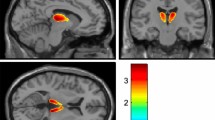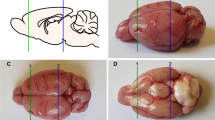Summary
-
1.
In various areas of the brainstem: nucleus caudatus, putamen, gyrus cinguli, oral and caudal part of substantia nigra, nucleus amygdalae, globus pallidus, raphe, and nucleus ruber L-tyrosine, dopamine, noradrenaline, L-tryptophan, serotonin and 5-hydroxyindoleacetic acid were investigated in eight cases of deceased L-Dopa psychosis, six cases of parkinsonian patients without psychotic symptoms, and in nine controls.
-
2.
The values of L-tyrosine in all investigated areas were increased in parkinsonian patients as well as in L-Dopa psychosis.
-
3.
The dopamine levels in all areas were decreased in both groups.
-
4.
Noradrenaline shows moderate slight increase in six out of nine regions in the psychotic group, when compared to parkinsonian patients without psychotic symptoms.
-
5.
L-tryptophan levels in the psychotic group are decreased in all areas, whereas levels in parkinsonian patients without psychotic symptoms are equal to those of the Controls.
-
6.
The 5-hydroxytryptamine levels in the psychotic group are increased in eight of nine regions, when compared to parkinsonian patients without psychotic symptoms, predominantly in the nucleus ruber, somewhat less in the raphe, and in the globus pallidus.
-
7.
5-hydroxyindoleacetic acid levels show a similar pattern as 5-HT.
-
8.
The loss of balance will be discussed as trigger of the psychotic symptoms.
Similar content being viewed by others
Abbreviations
- L-DOPA:
-
3, 4-Dihydroxy-phenylalanine
- Try:
-
L-Tryptophan
- Tyr:
-
L-Tyrosine
- 5-HT:
-
Serotonin (=5-Hydroxytryptamine)
- DA:
-
Dopamine (=3-Hydroxytyramine)
- 5-HIAA:
-
5-Hydroxyindoleacetic acid
- NA:
-
Noradrenaline (=Norepinephrine)
- HVA:
-
Homovanillic acid
- MHPG:
-
3-Methoxy-4-hydroxyphenylglycol
References
Aghajanian, G. K., andR. S. Bunney: Central Dopaminergic Neurons: Neurophysiological Identification and Responses to Drugs. Frontiers in Catecholamines: III. Int. Catecholsymp. Straßburg, May 20–25, 1973.
Anton, A. H., andD. F. Sayre: The Distribution of Dopamine and Dopa in Various Animals and a Method for their Determination in Diverse Biological Material. J. Pharmacol. Exp. Ther.145, 326–336 (1964).
Ashcroft, G. W., andF. D. Sharman: Drug Induced Changes in the Concentration of 5-OR Indolyl Compunds in the Cerebrospinal Fluid and Caudate Nucleus. Brit. J. Pharmacol.19, 153–160 (1962).
Bartholini, G., M. Da Prada, andA. Pletscher: Decrease of Cerebral 5-Hydroxytryptamine by 3, 4-Dihydroxyphenylalanine after Inhibition of Extracerebral Decarboxylase. J. Pharm. Pharmac.20, 228–229 (1968).
Bernheimer, H., W. Birkmayer, andO. Hornykiewicz: Verteilung des 5-Hydroxytryptamins (Serotonin) im Gehirn des Menschen und sein Verhalten bei Patienten mit Parkinson-Syndrom. Klin. Wschr.39, 1056 to 1059 (1961).
Bertler, A., A. Carlsson, andE. Rosengren: A Method for the Fluorometric Determination of Adrenaline and Noradrenaline in Tissues. Acta Physiol. Scand.44, 273–292 (1958).
Birkmayer, W.: Experimentelle Befunde und neue Aspekte bei extrapyramidalen Erkrankungen. Wien. Z. Nervenheilk.23, 128–139 (1966).
Birkmayer, W., andM. Mentasit: Weitere experimentelle Untersuchungen über den Catecholaminstoffwechsel bei extrapyramidalen Erkrankungen (Parkinson-und Chorea-Syndrom). Arch. Psychiat. Z. f. d. ges. Neurologie210, 29–35 (1967).
Birkmayer, W.: The Importance of Monoamine Metabolism for the Pathology of the Extrapyramidal System. J. Neuro-Visceral Rel., Suppl. IX, 297–308 (1969).
Birkmayer, W., andE. Neumayer: Die Behandlung der Dopa-Psychosen mit L-Tryptophan. Nervenarzt43, 76–78 (1972).
Birkmayer, W., W. Danielczyk, E. Neumayer, andP. Riederer: The Balance of Biogenic Amines as Condition for Normal Behaviour. J. Neural Transm.33, 163–178 (1972 a).
Birkmayer, W., andE. Neumayer: Die moderne medikamentöse Behandlung des Parkinsonismus. Z. Neurol.202, 257–280 (1972 b).
Birkmayer, W., L. Ambrozi, E. Neumayer, andP. Riederer: Longevity in Parkinson's Disease Treated with L-Dopa. X. Int. Congr. Neurology, Barcelona, Spain, September 8–15, 1973. (In press.)
Birkmayer, W., W. Linauer, M. Mentasti, andP. Riederer: Zweijährige Erfahrungen einer Kombinationsbehandlung des Parkinsonsyndroms mit L-Dopa und dem Decarboxylasehemmer Benserazid (Ro 4-4602). Wien. med. Wschr.22, 340–344 (1974).
Butcher, L. L., andJ. Engel: Behavioral and Biochemical Effects of L-Dopa after Peripheral Decarboxylase Inhibition. Brain Res.15, 233 (1969).
Carlsson, A.: Biochemical and Pharmacological Aspects of Parkinsonism. Acta Neurol. Scand., Suppl.51, 11–42 (1972).
Chase, T. N.: 5-Hydroxytryptophan in Parkinsonism. Lancet2, 1029 (1970).
Cotzias, G. C.: Levodopa in the Treatment of Parkinsonism. JAMA218, 1903–1908 (1971).
Everett, G. M., andJ. W. Borcherding: L-DOPA: Effect on Concentrations of Dopamine, Norepinephrine and Serotonin in Brains of Mice. Science6, 849–850 (1970).
Gehlen, W., andJ. Müller: Zur Therapie der Dopa-Psychosen mit L-Tryptophan. Dtsch. med. Wschr.99, 457–463 (1974).
Gogolák, G., andCh. Stumpf: Action of Anesthetics on the Firing Pattern of Nucleus Ruber Neurons. Naunyn-Schmiedeberg's Arch. Pharmacol.272, 387–394 (1972).
Goldstein, M., B. Anagnoste, A. F. Battista, W. S. Owen, andS. Nakatani: Studies of Amines in the Striatum in Monkeys with Nigral Lesions. The Disposition, Biosynthesis and Metabolites of3H-Dopamine and S14C-Serotonin in the Striatum. J. Neurochem.16, 645–653 (1969).
Goldstein, M., B. Anagnoste, L. S. Freedman, M. Roffmann, R. G. Ebstein, K. Fuxe, andT. Hökfelt: Characterization, Localization and Regulation of Dopamine-β-Hydroxylase and of the Catecholamine Synthetizing Enzymes. Frontiers in Catecholamines: III. Int. Catecholsymp. Strassbourg, May 20–25, 1973, Vol. XIII, p. 53–55.
Hess, S., andS. Udenfriend: A Fluorometric Procedure for the Measurement of Tryptamin in Tissues. J. Pharm. Exp. Ther.127, 175–181 (1959).
Hoehn, M. M., andM. D. Yahr: Parkinsonism. Onset, Progression and Mortality. Neurology (Minneap.)1967, 427–442.
König, H.: Zur Psychopathologie der Paralysis agitans. Arch. Psychiatr.50, 285–305 (1912).
Lehmann, J.: Tryptophan Malabsorption in Levodopa-Treated Parkinsonian Patients. Acta med. scand.194, 181–189 (1973).
Maj, J., L. Baran, M. Grabowska, andH. Sowinska: Effect of Clonidine on the 5-Hydroxytryptamine and 5-Hydroxyindoleacetic Acid Brain Levels. Biochem. Pharmacol.22, 2679–2683 (1973).
Malliè, A. H.: Les troubles psychiques chez les parkinsoniens. Thèse, Bordeaux, 1908.
Miller, E. M., andH. A. Nieburg: L-Tryptophan in the Treatment of Levodopa Induced Psychiatrie Disorders. Dis. Nervous System35, 20–23 (1974).
Moir, A. T. B.: Interaction in the Cerebral Metabolism of the Biogenic Amines: Effect of Intravenous Infusion of L-Tryptophan on the Metabolism of Dopamine and 5-Hydroxyindoles in Brain and Cerebrospinal Fluid. Brit. J. Pharmacol.43, 715 (1971).
Ng, K. Y., T. N. Chase, R. W. Coburn, andI. J. Kopin: L-Dopa-induced Release of Cerebral Monoamines. Science170, 76–77 (1970).
Olszewski, J., andD. Baxter: Cytoarchitecture of the Human Brain Stem. Basel-New York: Karger. 1954.
Poirier, L. J., P. Singh, T. L. Sourkes, andR. Boucher: Effect of Amine precursors in the Concentration of Striatal Dopamine and Serotonin in Cats with and without Unilateral Brain Stem Lesions. Brain Res.6, 654–666 (1967).
Quay, W. B.: Differential Extractions for the Spectrophotofluorometric Measurement of Diverse 5-Hydroxy- and 5-Methoxyindoles. Anal. Biochem.5, 51–59 (1963).
Rinne, U. K., V. Sonninen, andM. Hyyppä: Effect of L-Dopa on Brain Monoamines and their Metabolites in Parkinson's Disease. Life Sciences Part 1,10 (No. 10), 549–557 (1971).
Waalkes, T. P., andS. Udenfriend: A Fluorometric Method for the Estimation of Tyrosine in Plasma and Tissues. J. Lab. Clin. Med.50, 733 (1957).
Ward, A. A., jr.: Physiology of Basal Ganglia. In: Handbook of Clinical Neurology (Kuhen, P. J., andG. W. Bruyn, eds.) 1968.
Author information
Authors and Affiliations
Rights and permissions
About this article
Cite this article
Birkmayer, W., Danielczyk, W., Neumayer, E. et al. Nucleus ruber and L-Dopa psychosis: Biochemical post-mortem findings. J. Neural Transmission 35, 93–116 (1974). https://doi.org/10.1007/BF01250738
Received:
Issue Date:
DOI: https://doi.org/10.1007/BF01250738




